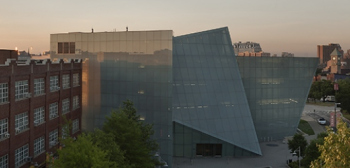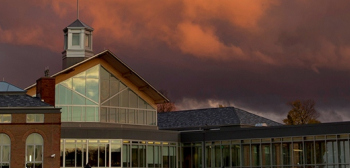- #=452 QS Global World Ranking
- PublicStatus
- Very HighResearch Output
- 24,358Total Students
- 2,495Faculty
- 4,681Int'l Students
QS Global World Ranking
The University’s position in the current QS World University Rankings.
The University’s position in the current QS World University Rankings.
Status
Whether the University is funded by the government of that country or state, or funded by private donations.
Whether the University is funded by the government of that country or state, or funded by private donations.
Research Output
The research intensity of the University, based on the number of papers output relative to the University’s size.
The research intensity of the University, based on the number of papers output relative to the University’s size.
Total Students
The number of full time equivalent students enrolled at the University.
The number of full time equivalent students enrolled at the University.
Faculty
The number of full time equivalent teaching staff employed by the University.
The number of full time equivalent teaching staff employed by the University.
Int'l Students
The number of full time equivalent international students enrolled at the University.
The number of full time equivalent international students enrolled at the University.
Stony Brook University, State University of New York
About
Read more
Read less
Stony Brook University is one of America’s most dynamic public universities and a magnet for outstanding students. A member of the elite Association of American Universities, Stony Brook is one of the 62 top research institutions in North America, with $182.7 million in annual sponsored research and 1,866 active research projects. Stony Brook faculty are leaders in significant national and worldwide projects, including uncovering the causes of lobster mortality in Long Island Sound, searching for the origins of man in Kenya’s Turkana Basin, and managing the national parks of Madagascar. They have made significant contributions to NASA initiatives, such as examining Martian minerals for evidence of life and other phenomena, and their work has led to such groundbreaking discoveries as a new species of mouse lemur, the smallest primate in the world; the cause of Lyme disease; and the invention of the MRI technology that won the Nobel Prize for Medicine. Stony Brook offers more than 200 undergraduate programs, 100 master’s programs and 40 doctoral programs, residing in 12 colleges and schools: College of Arts and Sciences, College of Business, College of Engineering and Applied Sciences, Graduate School, School of Dental Medicine, School of Health Technology and Management, School of Journalism, School of Marine and Atmospheric Sciences, School of Medicine, School of Nursing, School of Professional Development and School of Social Welfare. Stony Brook’s Undergraduate Colleges for freshmen provide a close-knit residential-based community, featuring small first-year seminars and close connections to faculty. The student retention rate is 91.6 percent. Our undergraduates are encouraged to explore — in the laboratory through our Undergraduate Research and Creative Activities program, the rainforests of Madagascar, or Discovery Bay in Jamaica, West Indies. The School of Marine and Atmospheric Sciences features waterfront learning at Stony Brook Southampton’s new Marine Sciences Research Center. And Stony Brook’s study abroad programs provide unique learning opportunities in countries around the globe, including Argentina, Italy, Jamaica, Korea, Madagascar and Tanzania. Stony Brook’s diverse student body includes roughly 16,000 undergraduates and 8,000 graduate and professional students from nearly all 50 states and more than 100 countries. Stony Brook is a highly selective institution that enrolls students who demonstrate the intellectual curiosity and academic ability to succeed. Stony Brook was one of only 10 universities given a recognition award by the National Science Foundation for integrating research and education at the undergraduate level. Opportunities for first-rate graduate and undergraduate research abound. Stony Brook students are offered unique research opportunities at nearby Brookhaven National Laboratory — co-managed by the University — whose facilities include the Relativistic Heavy Ion Collider, Center for Functional Nanomaterials, National Synchrotron Light Source, National Synchrotron Light Source II, NASA Space Radiation Facility, Accelerator Test Facility, Computational Science Center, and Brookhaven Linac Isotope Producer. The Laboratory’s almost 3,000 scientists, engineers and staff are joined each year by more than 4,000 visiting researchers from around the world. Brookhaven research has been honored by seven Nobel Prizes. The C.N. Yang Institute for Theoretical Physics, founded by Nobel Prize-winning physicist and Stony Brook Professor Emeritus Chen Ning Yang, is a leading center for high-energy physics, string theory and statistical mechanics. The Laufer Center for Physical and Quantitative Biology seeks to advance biology and medicine through discoveries in physics, mathematics and computational science. Researchers from around the world also gather at the University’s Simons Center for Geometry and Physics, where they explore synergies between theoretical physics and mathematics to deepen our understanding of the physical universe. Stony Brook’s Center of Excellence in Wireless and Information Technology (CEWIT) and two state-designated Centers for Advanced Technology — in diagnostic tools and sensor systems and in biotechnology — facilitate partnerships between New York State industry and University research. The Advanced Energy Research and Technology Center (AERTC) brings together academic and research institutions, energy providers and industry to focus on innovative energy solutions. The entrepreneurial energy and economic strength of the University bring a combined benefit of $4.6 billion to the region’s economy. The University is the largest single-site employer in the region, with more than 14,000 full- and part-time employees. Through its high-technology incubators, the University has promoted the launch of 44 companies. Stony Brook Medicine, the region’s premier academic medical center, encompasses Stony Brook University Hospital,...
About
Stony Brook University is one of America’s most dynamic public universities and a magnet for outstanding students. A member of the elite Association of American Universities, Stony Brook is one of the 62 top research institutions in North America, with $182.7 million in annual sponsored research and 1,866 active research projects. Stony Brook faculty are leaders in significant national and worldwide projects, including uncovering the causes of lobster mortality in Long Island Sound, searching for the origins of man in Kenya’s Turkana Basin, and managing the national parks of Madagascar. They have made significant contributions to NASA initiatives, such as examining Martian minerals for evidence of life and other phenomena, and their work has led to such groundbreaking discoveries as a new species of mouse lemur, the smallest primate in the world; the cause of Lyme disease; and the invention of the MRI technology that won the Nobel Prize for Medicine. Stony Brook offers more than 200 undergraduate programs, 100 master’s programs and 40 doctoral programs, residing in 12 colleges and schools: College of Arts and Sciences, College of Business, College of Engineering and Applied Sciences, Graduate School, School of Dental Medicine, School of Health Technology and Management, School of Journalism, School of Marine and Atmospheric Sciences, School of Medicine, School of Nursing, School of Professional Development and School of Social Welfare. Stony Brook’s Undergraduate Colleges for freshmen provide a close-knit residential-based community, featuring small first-year seminars and close connections to faculty. The student retention rate is 91.6 percent. Our undergraduates are encouraged to explore — in the laboratory through our Undergraduate Research and Creative Activities program, the rainforests of Madagascar, or Discovery Bay in Jamaica, West Indies. The School of Marine and Atmospheric Sciences features waterfront learning at Stony Brook Southampton’s new Marine Sciences Research Center. And Stony Brook’s study abroad programs provide unique learning opportunities in countries around the globe, including Argentina, Italy, Jamaica, Korea, Madagascar and Tanzania. Stony Brook’s diverse student body includes roughly 16,000 undergraduates and 8,000 graduate and professional students from nearly all 50 states and more than 100 countries. Stony Brook is a highly selective institution that enrolls students who demonstrate the intellectual curiosity and academic ability to succeed. Stony Brook was one of only 10 universities given a recognition award by the National Science Foundation for integrating research and education at the undergraduate level. Opportunities for first-rate graduate and undergraduate research abound. Stony Brook students are offered unique research opportunities at nearby Brookhaven National Laboratory — co-managed by the University — whose facilities include the Relativistic Heavy Ion Collider, Center for Functional Nanomaterials, National Synchrotron Light Source, National Synchrotron Light Source II, NASA Space Radiation Facility, Accelerator Test Facility, Computational Science Center, and Brookhaven Linac Isotope Producer. The Laboratory’s almost 3,000 scientists, engineers and staff are joined each year by more than 4,000 visiting researchers from around the world. Brookhaven research has been honored by seven Nobel Prizes. The C.N. Yang Institute for Theoretical Physics, founded by Nobel Prize-winning physicist and Stony Brook Professor Emeritus Chen Ning Yang, is a leading center for high-energy physics, string theory and statistical mechanics. The Laufer Center for Physical and Quantitative Biology seeks to advance biology and medicine through discoveries in physics, mathematics and computational science. Researchers from around the world also gather at the University’s Simons Center for Geometry and Physics, where they explore synergies between theoretical physics and mathematics to deepen our understanding of the physical universe. Stony Brook’s Center of Excellence in Wireless and Information Technology (CEWIT) and two state-designated Centers for Advanced Technology — in diagnostic tools and sensor systems and in biotechnology — facilitate partnerships between New York State industry and University research. The Advanced Energy Research and Technology Center (AERTC) brings together academic and research institutions, energy providers and industry to focus on innovative energy solutions. The entrepreneurial energy and economic strength of the University bring a combined benefit of $4.6 billion to the region’s economy. The University is the largest single-site employer in the region, with more than 14,000 full- and part-time employees. Through its high-technology incubators, the University has promoted the launch of 44 companies. Stony Brook Medicine, the region’s premier academic medical center, encompasses Stony Brook University Hospital,...
Campus locations
Stony Brook,
Stony Brook University , Stony Brook , New York , United States , 11794
Southampton,
39 Tuckahoe Road , Southampton , New York , United States , 11968
Similar Universities
Rochester Institute of Technology (RIT)
Lomb Memorial Drive, Rochester
Seton Hall University
400 S Orange Ave, South Orange, South Orange
Maryland Institute College of Art
1300 W. Mount Royal Avenue, Baltimore
Savannah College of Art and Design
516 Drayton St, Savannah
George Washington University School of Business
George Washington University, Washington D.C.
University of Texas Arlington
701 S. Nedderman Drive, Arlington
Related content

Ranked: The Top 100 US Unive…
By
Craig
OCallaghan
Updated
8.1k
29

10 of the Most Improved Univ…
By
Sabrina
Collier
Updated
116
0
Test preparations
Featured University


Sponsored
438
QS World University Rankings
-
10 UG & 47 PGTotal courses
-
Private for ProfitStatus
-
HighResearch output
Stony Brook University, State University of New York
EN














